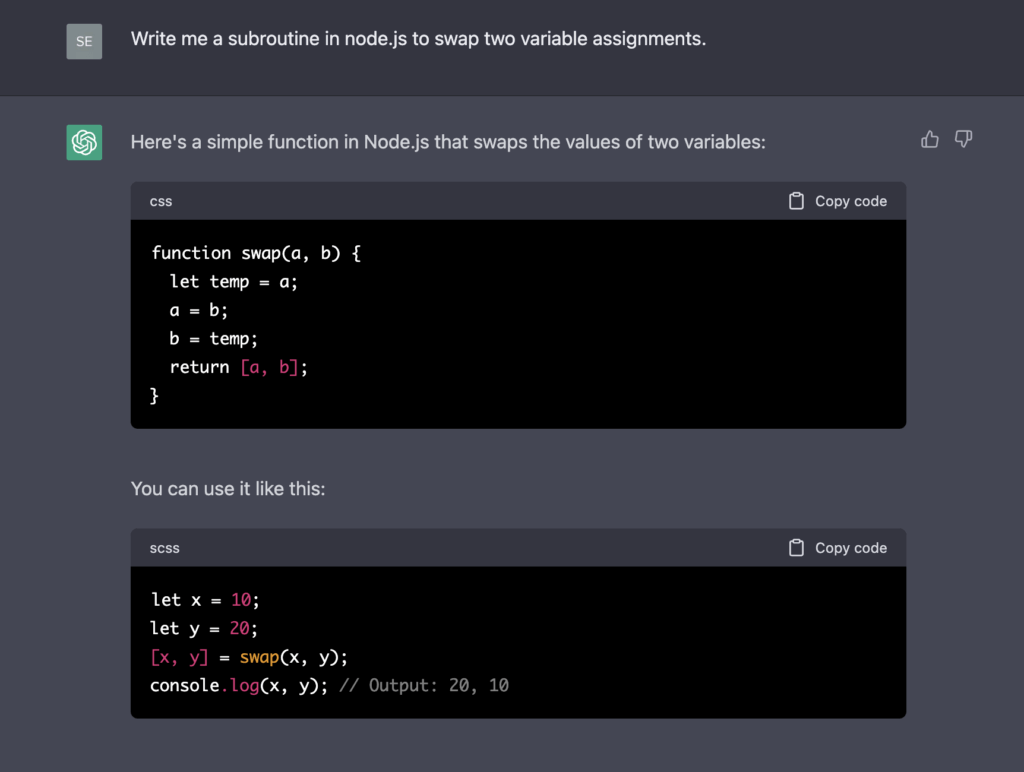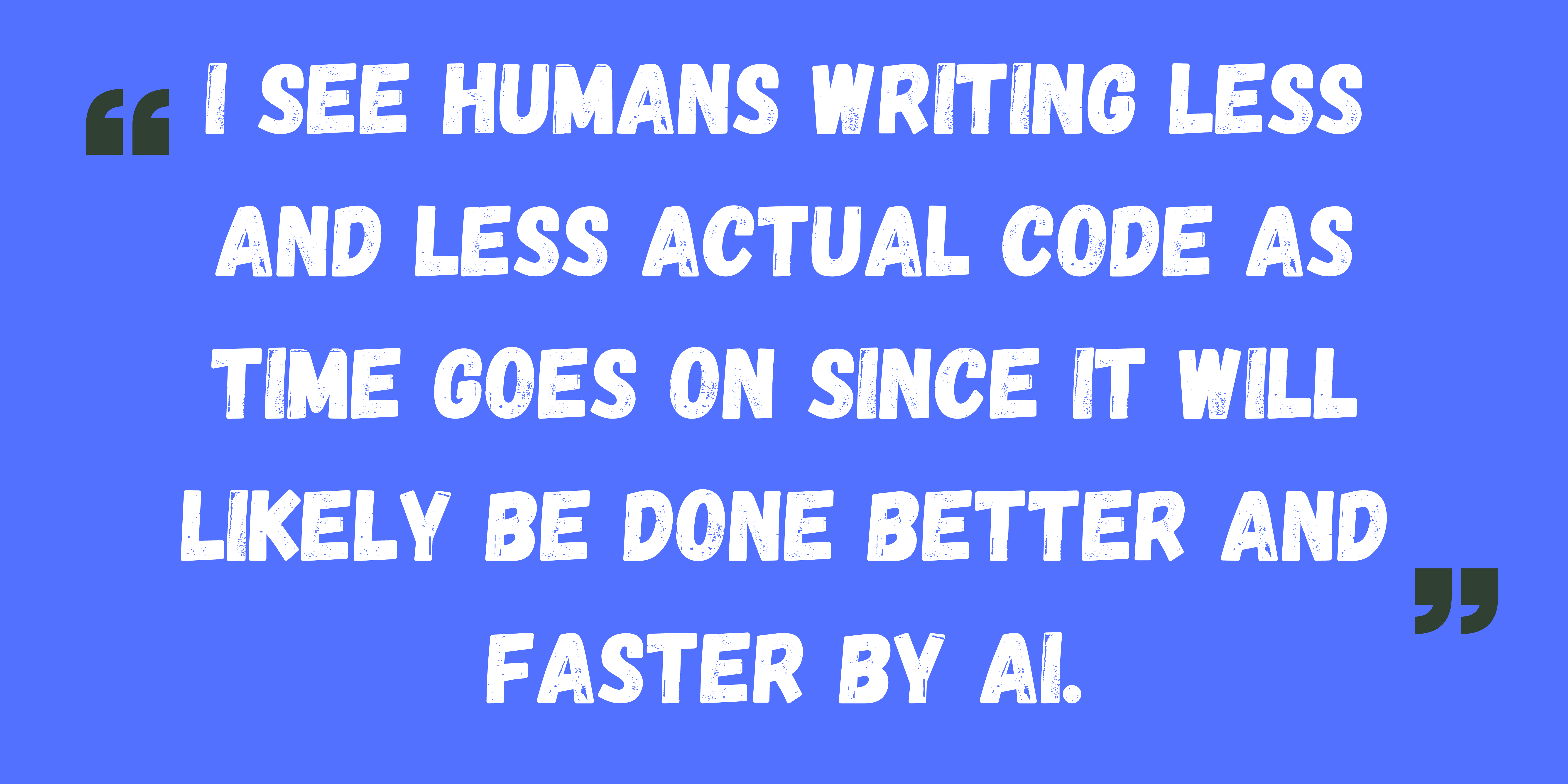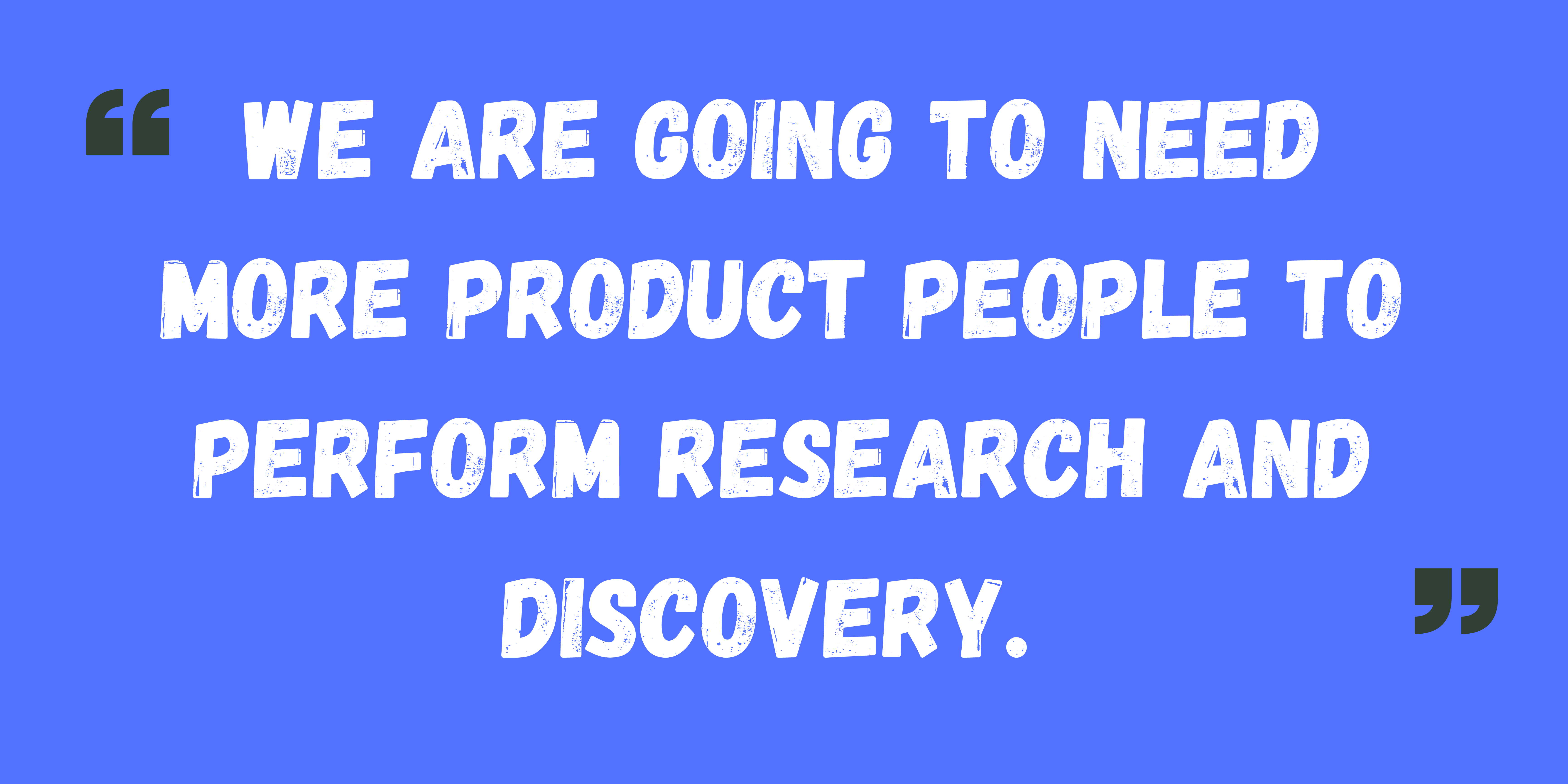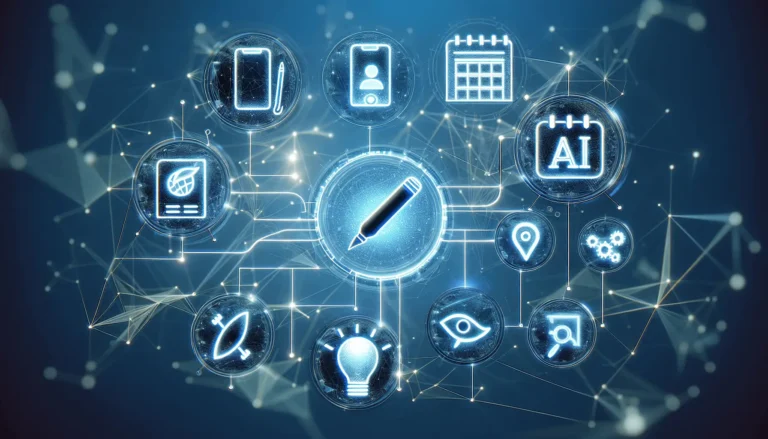Ever since ChatGPT was released, debate has circled around what it will mean for jobs everywhere as AI tools continue to become more advanced in their capabilities.
As a SaaS consultant, I help companies build and strengthen their product teams. I want to talk more about how I see product teams changing as they begin to incorporate the value AI tools can provide.
Background
If you are unfamiliar with OpenAI, it is a company building tools like the ChatGPT. Built into ChatGPT is their OpenAI Codex which enables ChatGPT to translate natural language to code.
Below is a simple example of me asking ChatGPT to write me a subroutine for swapping variables around. This is a common technique to teach students when learning a programming language. The tool spit this out in a few seconds. It even tested it and showed me how to use it. Honestly this would have been better instruction than I learned back in my university program a million years ago. Thank you professor ChatGPT.

Right now the big problem with software engineering is that it is the bottleneck in the product development process. As such, most of the resources in product teams have been dedicated to alleviating this bottleneck in any way possible.
This has typically meant most hires and typically the highest salaries have been paid to engineering teams because finding and keeping this talent has been a challenge for even the most popular tech companies
However, if there’s anything we know about technology and its evolution, these advantages typically only last for so long. Eventually, enough innovation makes its way to the market which eliminates the bottleneck and causes it to move. I believe that’s what we’re about to experience with the advent of tools like ChatGPT since they can now perform software engineering related tasks.
Tools like ChatGPT will be used to dramatically speed up the process of writing code and building applications. This is going to mean BIG changes to product teams everywhere. I believe it will rebalance what teams look like and even what they focus their efforts on primarily. There are already numerous articles like this one which detail how companies are planning to leverage tools like ChatGPT to replace at least some software engineers.
Let’s talk about what the evolution of product teams is going to look like.
Smaller Engineering Teams
The first change may be relatively obvious in that we are likely to see engineering teams shrink since less engineers will be required to complete the work as tools like ChatGPT pick up more of the effort. Many companies are experimenting with what these tools can do to help speed up the process of writing code in their engineering teams. If your immediate thought is that these tools won’t be able to perform complex tasks, I’ll stop you right there because ChatGPT has already passed Google’s level 3 software engineering interview and in reality these tools are just getting started.
What may be less obvious is how engineering teams are likely to change in composition as the list of in demand skills for software engineers evolve based on having access to these advanced resources. I believe that what’s being termed as ‘prompt engineering’ is likely to rise in demand as a skill that will make a software engineer more valuable. Prompt engineering is basically being able to ask the tool the right question to get the best answer as efficiently as possible.

I think we are likely to see teams retain more senior engineers and have less junior engineers. I’d expect the majority (if not all) of the work that was being completed by junior engineers to instead be delegated to tools like ChatGPT by the senior engineers. It will be important for engineers everywhere to embrace learning these skills to keep their value and marketability high. I believe it will be important to know how to write good code, but mainly for auditing purposes. I see humans writing less and less actual code as time goes on since it will likely be done better and faster by AI.
So those are some of the changes we might expect to engineering teams, let’s talk about potential changes to the other groups that makeup the product team.
How Product Teams Are Likely To Rebalance
With less engineers producing faster results, this means the product development bottleneck is likely to shift. If engineers are focused on how we build, someone still needs to own what we build and why what we’re planning to build is important. This role has typically been owned by product managers and user research teams. However, this area has typically not received consistent investment of time or resources by most companies. I believe this speaks to one of the biggest opportunities for product teams everywhere to improve the impact they will have on the product and ultimately the company’s success.
Discovery and research can produce powerful results. I talk a lot about how most development efforts are typically wasted because teams are not building value into their products. Despite knowing this, most teams have typically underinvested into discovery and research. I believe this was likely because engineering was seen as the biggest bottleneck to production. Even when teams knew what they needed to build, the process of actually building it was painfully slow. As such, most investment historically has been to try and speed the software engineering part of the process up. However, with the addition of these tools, I think it opens up some exciting possibilities to reinvest into these areas of impact for product teams.

I think we are likely to see product teams everywhere performing more discovery and research because it will become even more obvious that we are shipping the wrong features. Since engineering teams will be producing faster results, the frequency of realizing that we often ‘miss’ expectations of our customers and users will become painfully obvious. This is likely to motivate executive teams everywhere to fix this problem which I believe will become the new bottleneck. As such, I see more product people and researchers on our product teams. I believe this also means we are going to need more product people and researchers.
So we know that product teams are likely to rebalance, let’s talk about what will likely be the renewed focus of their efforts and what the new bottlenecks may be.
Discovery and Research
All development efforts should begin with a clear picture of what we are planning to build and why that is important. Unfortunately, most engineering backlogs are missing some or all of this information. As such, most of what we ship misses the mark and requires either rework or for us to rip out that feature at a later date.
With engineering teams becoming more efficient that will make way for product teams to invest more time into discovery and research. However, this process can be difficult and time consuming to build and manage. I believe this is where we will see the majority of the focus for the additional resources added to product teams. This will help alleviate some of this burden, but won’t be enough to eliminate it as a bottleneck. We don’t want engineering resources sitting around idle. As such, we need to speed this process up considerably as well.
There are lots of tools on the market to help product teams manage their product discovery and research process more efficiently. Tools like Dovetail provide you with the ability to capture dialogue with customers and users more easily and import it into their platform so you can extract valuable insights. I also recommend powerful tools like MonkeyLearn to provide advanced capabilities using Natural Language Processing (NLP) technology to highlight our research and dialogue by sentiment and other important evaluation categories.

Regardless, product teams need to be prepared to own discovery and research and manage it more efficiently than they have in years past. Their ability to learn these skills quickly will be a key component to how successful ultimately their product and company can become.
As a SaaS consultant, I know a lot about how to build this process and leverage these tools to improve its effectiveness and efficiency. I even offer research sprints as a service in an effort to help you capture the voice of your customer.
Now that we know what everyone on the product team should be doing to prepare, let’s see a historical example of a game changing technology from years past and how it evolved the technical teams that embraced it.
The Rise Of Virtualization
I’ve been in tech for so long that sometimes I say that I was born in a data center. I’m THAT big of a geek. I’ve been around computers and technology since the beginning and have always kept a close eye on what’s next. As such, I want to share a story of my time in industry when I was working at a technical operation center to help alleviate the concerns of our executive team as it looked like we might actually run out of resources to manage our IT infrastructure.
Back in 2007, applications ran exclusively on physical servers and those same servers required a lot of infrastructure to run well. It was a ton of cabling, rack mount space, cooling, hardware support etc. that was necessary to maintain the infrastructure. As you can imagine this was VERY expensive. As such, the physical limitations of these servers became a painful bottleneck. The demand for resources was growing exponentially and we couldn’t come close to keeping up with demand for growth.
In fact, our projection was that we’d run out of physical space to even put servers by the end of the year. This was a real problem and we didn’t know how we were going to solve it. That was at least until virtualization technology was invented. Virtualization made it possible to share resources across physical servers. This made it possible to pool the resources and carve out virtual instances (or virtual servers) however and whenever we needed them.

As virtualization exploded the physical presence of server infrastructure went down, not up. Data centers become smaller and more centralized. Costs to manage and maintain them dropped significantly as well. This also gave rise to a shifting skillset. No longer was it as important to know how to maintain servers physically, but virtually which helped raise the status of engineers with software skills who could come up with exciting new automation capabilities to push the boundaries of what this new technology made possible even further.
As such, technical teams changed size and shape. Hardware skills became less valuable and software skills rose considerably in demand. As technology evolves so do the teams that are expected to manage it.
Summary
Tools like ChatGPT from OpenAI are expected to alleviate what has been the BIG bottleneck in product development (software engineering). This is likely to mean changes to product teams everywhere. I think we’ll see smaller engineering teams capable of doing more which will mean an exponential improvement to the throughput of writing code and building applications for product companies everywhere.
Product teams will likely rebalance in the direction of the new bottleneck which is likely to be discovery and research. We’ll see even more tools and resources come to market in an effort to alleviate this new bottleneck as product teams invest more in identifying the why behind the what that they build.
You need to invest in your product teams to know how to best leverage these tools so as to not get left behind as this new wave of technological evolution continues to materialize.
Hi there, I’m Sean and I’m a B2B SaaS consultant. I help product teams everywhere find product-market fit faster by quickly identifying and eliminating their bottlenecks to progress. To learn more about how I may be able to help your team book a free product strategy call.


